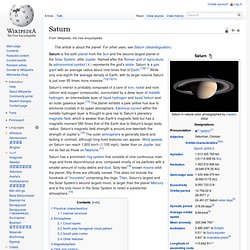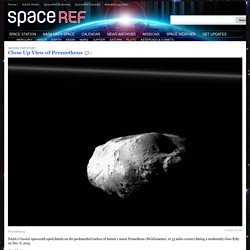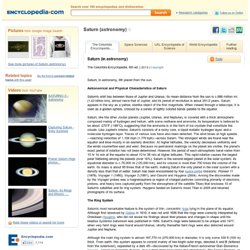

Saturn5. Saturn3. Earth. Earth means:In astronomy mythology, her Greek name was Gaea.

Earth was the mother of the mountains, valleys, streams and all other land formations. She was married to Uranus. How Big is the Earth? The Earth is the biggest of all the terrestrial planets. A terrestrial planet is a dense planet found in the inner Solar System. The Planet Our planet is an oasis of life in an otherwise desolate universe. To learn more about Earth, please visit our Earth Sciences website. Moons: The Earth has one moon. Saturn1. Saturn l Saturn facts, pictures and information. Saturn is the sixth planet from the Sun and the second largest.

Planet Profile orbit: 1,429,400,000 km (9.54 AU) from Sundiameter: 120,536 km (equatorial)mass: 5.68e26 kg History of Saturn In Roman mythology, Saturn is the god of agriculture. The associated Greek god, Cronus, was the son of Uranus and Gaia and the father of Zeus (Jupiter). Saturn has been known since prehistoric times. Saturn was first visited by NASA's Pioneer 11 in 1979 and later by Voyager 1 and Voyager 2. Saturn is visibly flattened (oblate) when viewed through a small telescope; its equatorial and polar diameters vary by almost 10% (120,536 km vs. 108,728 km). Saturn2. Facts for Kids- Saturn. Kids - Our Universe - Test your knowledge on Saturn! Saturn. Astronomy for Kids: The Planet Saturn. Moons: 60 (and growing) Mass: 95 times the mass of Earth Diameter: 74,900 miles Year: 29.4 Earth years Day: 10.7 hours Temperature: -215 degrees F Distance from the Sun: 6th planet from the sun, 887 million miles What is Saturn like?

Saturn - The Planet Saturn - Saturn For Kids. Saturn is the sixth planet in the Solar system and, when seen through a telescope, by far the most beautiful.

The bright globe of Saturn is surrounded by rings which may be composed of ice. Three of these rings are visible from the Earth using a telescope. Photographs sent back from the US Voyager spacecraft in the 1980s were able to identify further narrower rings “ringlets” in between the three main rings. The main rings are labelled A, B and C, with A the outermost ring. Recently more rings have been found. Figure 1: Photograph of Saturn taken from Voyager spacecraft. Saturn is the last planet that can be seen without using a telescope or binoculars and the planet was known in the ancient world before telescopes were invented. Saturn. Saturn's interior is probably composed of a core of iron, nickel and rock (silicon and oxygen compounds), surrounded by a deep layer of metallic hydrogen, an intermediate layer of liquid hydrogen and liquid helium and an outer gaseous layer.[15] The planet exhibits a pale yellow hue due to ammonia crystals in its upper atmosphere.

Electrical current within the metallic hydrogen layer is thought to give rise to Saturn's planetary magnetic field, which is weaker than Earth's magnetic field but has a magnetic moment 580 times that of the Earth due to Saturn's larger body radius. Saturn's magnetic field strength is around one-twentieth the strength of Jupiter's.[16] The outer atmosphere is generally bland and lacking in contrast, although long-lived features can appear. Wind speeds on Saturn can reach 1,800 km/h (1,100 mph), faster than on Jupiter, but not as fast as those on Neptune.[17] Physical characteristics. SpaceRef. Saturn TOP STORIES Tethys and Saturn Tethys and Saturn Tethys, dwarfed by the scale of Saturn and its rings, appears as an elegant crescent in this image taken by NASA's Cassini Spacecraft.

Peering Through Titan's Haze This composite image shows an infrared view of Saturn's moon Titan from NASA's Cassini spacecraft, acquired during the mission's ''T-114'' flyby on Nov. 13, 2015. Saturn. Encyclopedia.com articles about Saturn (astronomy) Saturn, in astronomy, 6th planet from the sun.

Astronomical and Physical Characteristics of Saturn Saturn's orbit lies between those of Jupiter and Uranus; its mean distance from the sun is c.886 million mi (1.43 billion km), almost twice that of Jupiter, and its period of revolution is about 291/2 years. Saturn appears in the sky as a yellow, starlike object of the first magnitude. When viewed through a telescope, it is seen as a golden sphere, crossed by a series of lightly colored bands parallel to the equator. Saturn, like the other Jovian planets (Jupiter, Uranus, and Neptune), is covered with a thick atmosphere composed mainly of hydrogen and helium, with some methane and ammonia; its temperature is believed to be about -270°F (-168°C), suggesting that the ammonia is in the form of ice crystals that constitute the clouds.
Saturn. Saturno4.